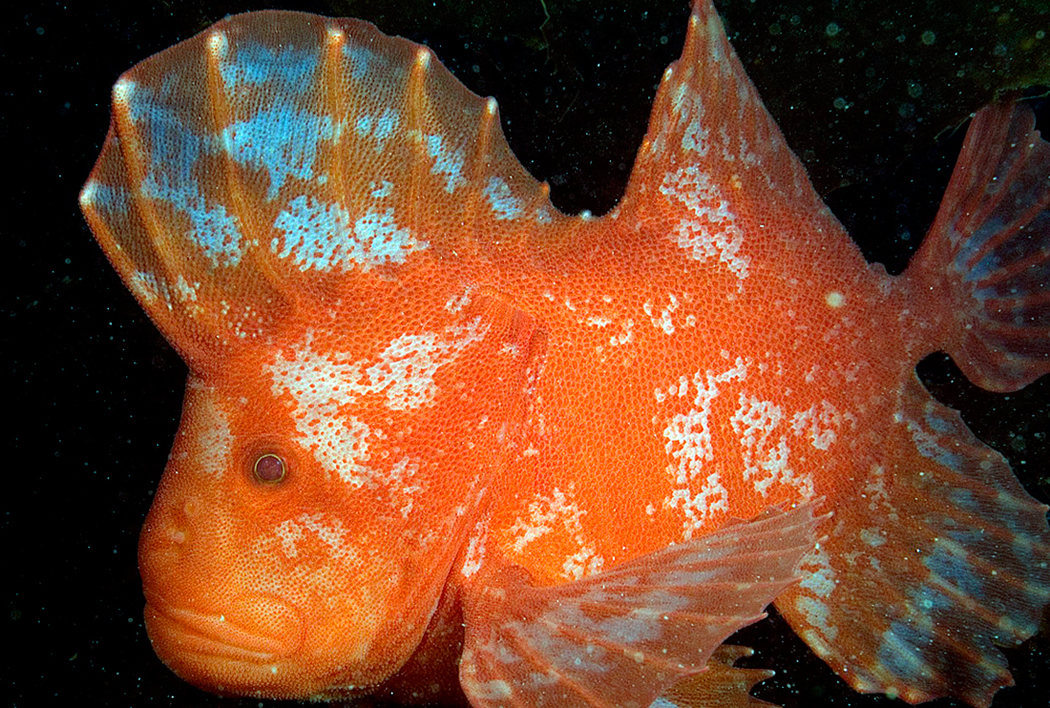Red Velvetfish, Gnathanacanthus goetzeei Bleeker 1855

A Red Velvetfish, Gnathanacanthus goetzeei, at Wilsons Promontory, Victoria. Source: Mark D. Norman / Museums Victoria. License: CC by Attribution
A striking scorpionfish relative with large rounded fins, a deeply-notched dorsal fin, and soft velvety skin covered in papillae. Adults are usually reddish-orange with paler marbling and mottling. Juveniles have pale translucent skin with scattered bright reddish spots, lines and ocelli.
Although relatively common in some areas, Red Velvetfish are surprisingly well-camouflaged amongst kelp and other macroalgae and are rarely encountered by divers.
The dorsal-fin spines are venomous and can inflict an excruciatingly painful and long-lasting wound.
Red Velvetfish, Gnathanacanthus goetzeei Bleeker 1855
More Info
|
Distribution |
Endemic to temperate waters of southern Australia, from about Lake Tyers, Victoria, to about Point Moore, near Geraldton, Western Australia, and in northern and eastern Tasmania and the Bass Strait islands. Red Velvetfish live amongst kelp and other macroalgae on sheltered rocky reefs, often in deeper caves and gutters, at depths to 55 m. They are difficult to detect due to their camouflage and behaviour, as they sway back and forth with the swell just like the kelp fronds. |
|
Features |
Dorsal fin XII-XIII, 9-10; Anal fin III, 8-10; Caudal fin 10-12; Pectoral fin 11; Pelvic fin I, 5; Lateral line (pores) 15-23. Body extremely compressed with a large head and large rounded fins; two separate or a deeply-notched dorsal fin with high rounded lobes, not attached to caudal fin; pelvic fins below pectoral fins, both large and rounded. Scales absent, soft velvety skin covered in papillae. |
|
Size |
To 46 cm |
|
Colour |
Usually mottled orange, red or brown, or even a deep pinkish-red. Juveniles have pale translucent skin with red spots, lines and ocelli. |
|
Feeding |
Ambush predators that feed mostly on crustaceans such as crabs and shrimps, and also on small fishes. |
|
Biology |
Little is known of the biology of the Red Velvetfish. |
|
Remarks |
Like their venomous scorpionfish relatives, Red Velvetfishes have a venom gland at the base of their spines and a glandular groove along the spine that transports venom from a gland at the spine base to the tip of the spine (Smith & Wheeler 2006). They should not be handled as the wound can be excruciatingly painful and long-lasting. |
|
Similar Species |
Although similar to the prowfishes of the family Pataecidae, red velvetfishes differ in having pelvic fins, two separate or a deeply-notched dorsal fin that is not attached to the caudal fin, and soft velvety skin covered in papillae. |
|
Etymology |
The species was named for J.W. Goetzee. |
|
Species Citation |
Gnathanacanthus goetzeei Bleeker, 1855, Verh. Akad. Amsterdam 2: 21 unnumbered pls (fig. 1)]. Type locality: Derwent River, Tasmania |
|
Author |
Bray, D.J. 2018 |
|
Resources |
Red Velvetfish, Gnathanacanthus goetzeei Bleeker 1855
References
Bleeker, P. 1855. Over eenige visschen van Van Diemensland. Verhandelingen der Koninklijke Akademie van Wetenschappen [Verh. Akad. Amsterdam] 2: 1-31 fig. 1
Castelnau, F.L. de 1878. Australian fishes, new or little known species. Proceedings of the Linnean Society of New South Wales 1 2(3): 225-248 pls 1-2 (as Beridia flava) See ref at BHL
Edgar, G.J., Last, P.R. & Wells, M.W. 1982. Coastal Fishes of Tasmania and Bass Strait. Hobart : Cat & Fiddle Press 175 pp.
Gomon, M.F. 1994. Family Gnathanacanthidae. pp. 512-514 fig. 457 in Gomon, M.F., Glover, C.J.M. & Kuiter, R.H (eds). The Fishes of Australia's South Coast. Adelaide : State Printer 992 pp. 810 figs.
Günther, A. 1876. Remarks on fishes, with descriptions of new species in the British Museum, chiefly from southern seas. Annals and Magazine of Natural History 4 17(43): 389-402 (as Holoxenus cutaneus) See ref at BHL
Hutchins, J.B. & Swainston, R. 1986. Sea Fishes of Southern Australia. Complete field guide for anglers and divers. Perth : Swainston Publishing 180 pp.
Hutchins, J.B. & Thompson, M. 1983. The Marine and Estuarine Fishes of South-western Australia. Perth : Western Australian Museum 103 pp. 345 figs.
Johnson, J.W. 2008. Family Gnathanacanthidae. p. 506 in Gomon. M.F., Bray, D.J. & Kuiter, R.H (eds). Fishes of Australia's Southern Coast. Sydney : Reed New Holland 928 pp.
Johnston, R.M. 1883. General and critical observations on fishes of Tasmania with a classified catalogue of all known species. Papers and Proceedings of the Royal Society of Tasmania 1882: 53-144 (as Holoxenus guentheri) Ref available online, open access
Kuiter, R.H. 1993. Coastal Fishes of South-eastern Australia. Bathurst : Crawford House Press 437 pp.
Kuiter, R.H. 1996. Guide to sea fishes of Australia. A comprehensive reference for divers and fishermen. Sydney, NSW, Australia : New Holland Publishers xvii, 434 pp.
Kuiter, R.H. 2000. Coastal Fishes of South-eastern Australia. Gary Allen. 437 pp.
Mandrytsa, S.A. 2001. Lateral Line System and Classification of Scorpaenoid Fishes (Scorpeaniformes: Scorpaenidei). Perm : Perm State Univ. Press pp. 1-393.
Paxton, J.R., Gates, J.E., Bray, D.J. & Hoese, D.F. 2006. Gnathanacanthidae. pp. 909-910 in Beesley, P.L. & Wells, A. (eds). Zoological Catalogue of Australia. Volume 35 Australia : ABRS & CSIRO Publishing Parts 1-3 2178 pp.
Scott, E.O.G. 1986. Observations on Tasmanian fishes. Part 31. Review of Gnathanacanthidae. Papers and Proceedings of the Royal Society of Tasmania 120: 51-75 figs 1-4
Smith, W.L. & W.C. Wheeler. 2006. Venom evolution widespread in fishes: a phylogenetic rode map for the bioprospecting of piscine venoms. J. Hered. 97(3): 206-217.
Washington, B.B., Eschmeyer, W.N. & Howe, K.M. 1984. Scorpaeniformes: relationships. Pp. 438-447 figs 240-241 in Moser, H.G. et al. (eds). Ontogeny and Systematics of Fishes. American Society of Ichthyologists and Herpetologists. Special Publication 1: 1-760










